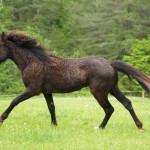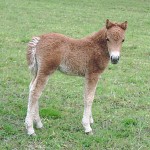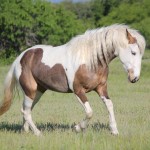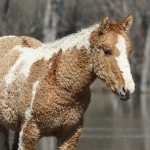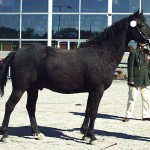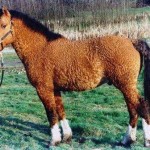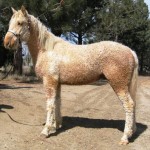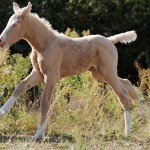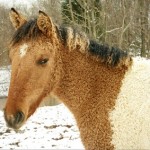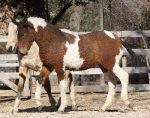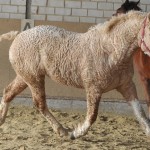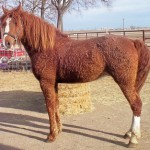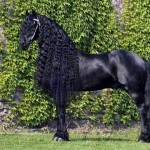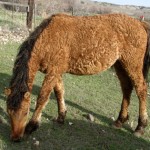Curly Horse
The Curly Horse, referred to as the Bashkir Curly, is known for its distinctive curly coat. The gene responsible for this unique trait can express itself minimally with the horse displaying curly hairs at its tail, mane, ankles, and inside the ears. Some horses may have the maximally dominant gene causing curly hairs to occur all over their body including the eyelashes, mane, and guard hairs. Others may exhibit extreme winter curls and a slightly wavy summer coat.
Curly Horse Pictures
- American Bashkir Curly Horse
- Baby Curly Horse
- Bashkir Curly Horse Pictures
- Bashkir Curly Horse
- Black Curly Horse
- Curly Hair Horse
- Curly Haired Horse
- Curly Horse Foal
- Curly Horse Images
- Curly Horse Pictures
- Curly Horse
- Curly Horses
- Curly Mane Horse
- Pictures of Curly Horse
Quick Information
| Alternative Names | American Curly Horse, North American Curly Horse, American Bashkir Curly |
| Common Nicknames | Curly |
| Temperament/Personality | Friendly, intelligent, quiet, calm, docile, reliable, level headed |
| Physical Characteristics | Solidly built with strong bones, straight legs, and wide chest; well-balanced body, rump, and shoulder; good strong hooves; bold movement with long strides; split manes without any twisted or interlaced hair |
| Colors | Chestnut is most common; blacks, grays, and bays are standard; cremello, grulla, roan, and buckskin are possible; pinto and appaloosa patterns are also seen |
| Common Use | In equestrianism, show jumping, dressage; for training beginner riders, western riding, combined driving; companions for trail horses and ranch horses |
| Lifespan/Life Expectancy | About 25 years |
| Weight | 800-1,200 lbs (363-544 kg) |
| Height (size) | 14-16 hands (142-163 cm, 56-64 inches); two registries also accept horses ranging from 8 to 19 hands (34 to 76 inches) |
| Health | A fit and sturdy breed with no known health issues |
| Gaited | Crossed with gaited horses such as Missouri Fox Trotters to create gaited Curlies; few offspring will do gaits like the stepping pace (Curly Shuffle), foxtrot, or the running walk |
| Popular Traits | Easily trainable; have great resilience and strength, tough constitution; more reasoning ability than other breeds; love to be around people |
| Feeding/Diet | Average healthy adults require top quality hay providing loose trace minerals; a fair amount of grain; and white salt block. Also provide enough quantity of fresh water on a regular basis |
| Blood Type | Warm |
| Country of Origin | United States of America |
| Ancestors | Its ancestry is highly debated; some theories suggest that it is a descendant of the Bashkir horse, while others propose that it originated from the Iberian; later, John Damele together with his sons developed the breed by adding Arabian and Morgan stallions to a herd of Curlies |
| Year/Time of Development | Early 20th century |
| Breed Information | Recognized and registered by the ABCR (American Bashkir Curly Registry), CCHA (Canadian Curly Horse Association), CSI (Curly Sporthorse International), ICHO (International Curly Horse Organization); ABCR Breed Standards |
Video: Curly Horse
History and Development
The foundation of the curly haired horse is still a mystery though research about its origin is in progress. It was thought that the Russian Bashkir, a horse with a curly coat from the republic of Bashkortostan, is an ancestor of the Curly Horse. However, this theory was found untrue because a 1990 research by S. Thomas proved that this Russian horse is, in fact, the Lokai breed.
As a result, confusion broke out regarding the breed’s name with some registries preferring to keep the term ‘Bashkir’ while the others were more inclined to removing it. The ABCR members called it “American Bashkir Curly”, but the ICHO and CSI members named it “North American Curly”.
Among the many theories of its origin, some suggest that these horses might have crossed the Bering Land Bridge and came to North America during the Ice Age. Other theories imply that they were brought to North America by the Russian settlers. However, none of the evidence found is yet to confirm these assumptions.
It is believed that these horses were recorded in 2nd-century Asian artwork. One theory implies that the Curlies were brought from India to Nevada by Tom Dixon during the late 19th-century. But these horses could not have been the foundation stock because the curly horse breeds were already owned by the Sioux Indians in the early 1800s. Another theory hints that they were brought to America by the Spanish conquistadors, and so it has Iberian ancestry.
Curly horses were rare in Nevada and were first documented by John Damele in the early 1900s. After few years, John and his sons managed to capture one of these horses, tamed it and eventually sold it. They were greatly impressed by the resilience and toughness of these horses, which were resistant to the harsh winter of 1932.
After another severe winter hit Nevada in 1951/52, the Dameles made up their mind about breeding these curly hair horses. They found a chestnut Curly in a herd of Mustangs and named it Copper D that became the foundation stallion of this breed for the Dameles. They introduced an Arabian stallion called Nevada Red AHR 18125, and a Morgan horse called Ruby Red King AMHR 26101 to the herd of Curlies. At present, these two stallions are found in the pedigrees of numerous curly haired horses.
Interesting Facts
- Surprisingly some Curly Horses, known as smooth coat curlies, are devoid of curls since the trait is heterozygous in them.
- This is the only horse breed that is said to be hypoallergenic.
- The hair shed from the tail and mane in spring is collected and given to the Curly Fiber Guild of International Curly Horse Organization. The hair is used by the fiber artists of the Guild for spinning, weaving, crocheting, and knitting.


